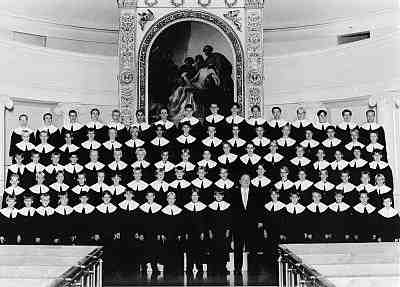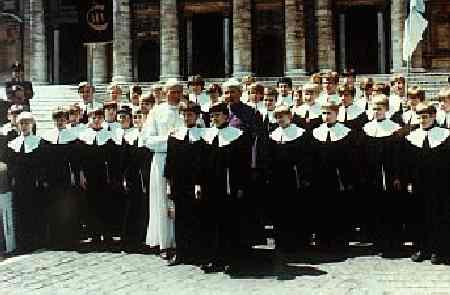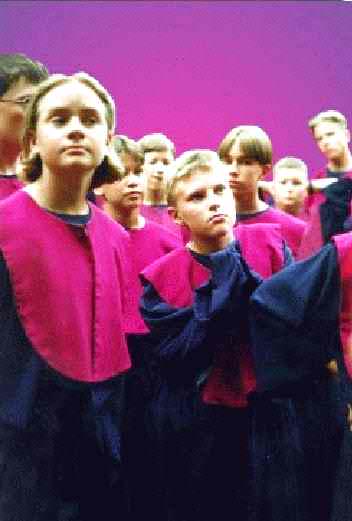
Figure 1.--The Cantores Minores Choir in Finland wear plain robes with large white collars.


Figure 1.--The Cantores Minores Choir in Finland wear plain robes with large white collars. |
Many countries of Western and Central Europe have a long tradition of church boys' choirs dating back to the medevil era. I note little about the Finnish tradition. The medeivel church's tradition of choir music appears to have diappeared with the Reformation.
Some choirs of recent foundation are attempting to revive the tradition. The existing choirs are of very recent origins.
Finland is the most easterly of the Scandinavian countries. The Finnish Language is a subdivision of the finno-Ugric branch of ther Ural-Altaic family of languages. Ther dominate religion since the Reformation is Luthern. There is a small number of Orthdox Christians as a result of Russian control achierved during the early 19th century during the Napoleonic Wars. Czar Alexander I peledged autonomy, but the Russians gradually attempted to impose Russian absolutism and the Russian language to which the Finns resisted. The Finns manged to achieve some degree of autonomy in the early 20th century and independence in the disorder associated with World War I and the Russian Revolution.
HBC has no information on boy choirs in the early Finnish church or after the Reformation in the 16th century. The existing Finnish choirs are of very recent origins.
Some information is available on one Helsinki choir.

Figure 2.--The Cantores Minores are seen here meeting with the Pope. |
The Cantores Minores, the Helsinki Cathedral Boys' Choir, was founded in December 1952 by Finnish pastor Tarmo Nuotio and Finnish-American Dr. Ruth-Esther Hillilä. The Cantores Minores represents the rare type of Protestant boys' choirs holding the great German choirs such as Bach's Thomanerchor in Leipzig and Schütz's Kreuzchor in Dresden as its models.
However, in contrast to the models which function as time-honoured boarding schools the boys of the Cantores Minores gather together four times a week to choir rehearsals from the Helsinki Metropolitan Area. Instead of 8 hours a day, the boys have music practise only 8 hours a week. All the same their aims equal those of their models. The Choir is a
SATB choir consisting of sopranos and altos aged 9-14 and male voices (tenors and basses) aged 13-20.
Over the past few decades the Cantores Minores has developed into an internationally acknowledged institution. During its 45-year history the choir has made altogether 32 concert tours abroad visiting 14 European countries as well as the United States and Japan. The repertoire of the CM includes a wide variety of music ranging from the 16th century music to the compositions of contemporary composers. Bach's passions, oratorios and masses are performed regularly forming a core of the choir's repertoire.
From the beginning the choir's intention was to continue the medieval tradition of ecclesiastical boys' choirs which has continued almost intact in the Catholic church and in the modified form after Reformation especially in Germany. In Finland this tradition had, however, become extinct since centuries.
As the Protestant choir acts as a choir school, it educates its own men's voices and is naturally a mixed choir in contrast to the Catholic choirs which usually consist of boys only and engage grown male singers when needed. The Protestant type of choir was the one for
which Johann Sebastian Bach wrote all his great choral works and these masterpieces still constitute the core of the repertoire of this type of boys' choirs. Both musically and educationally it gives the youngsters besides musical education also self-confidence, sustained awareness, and a strong commitment to excellence.
Auditions are held at least twice a year and some 40 boys aged 8 to 10 are yearly admitted to the Cantores Minores Choir School. After one year of instruction in musical theory, score reading and voice training and having passed appropriate examinations, the boys are admitted to the performing choir. Music education, rehearsing and voice training are intensified during camps held twice a year. In the fall of 1996 the Cantores Minores
approached its historical models by starting to cooperate with the school authorities of the City of Helsinki. The aim is to integrate school and choir work and thus allow the boys more time for training. The first 3 years of this project have been successful enabling the choir to raise it standards even further.
About 120 boys and young men of the main choir (Choir A) perform yearly at least two great works of Johann Sebastian Bach. The Passions according to St. Matthew and St. John are performed on Good Friday in alternate years, the Christmas Oratorio is sung every December. Bach's Mass in B Minor, Johannes Brahms' German Requiem and Mozart's Requiem are also performed at regular intervals. In addition, the Cantores Minores yearly prepares a repertoire of a cappella music consisting of pieces of all ages and styles up to the very modernest choral works. It is needed for the annual concert tours made both in Finland and abroad as well as for the many invited performances. Over the years the Cantores Minores has
performed many big choral works abroad, e.g. Mozart's Mass in D major with the Romsey Cathedral Orchestra in England in 1970, Cimarosa's Requiem in Poland in 1980, Bach's Mass in B Minor with the Staatskapelle Dresden in Germany in 1985 and 1996 as well as Beethoven's Mass in C major with the Phoenix Opera Orchestra in Arizona (USA) in 1988, Bach's St. John Passion in Dresden in 1991, Mozart's Requiem in Tokyo in 1997 and Bach's Christmas Oratorio in with Moscow Symp.
I believe this is an all girl choir and that they wear folk costumes. In England and western Europe the vocal tradition is anchored in the Church and as a result boy choirs have flourished. In Eastern Europe and Scandinavia where there has been a strong choral involvement in folk music, girl choirs have been more common.

Figure 3.--The Ynnin choristers are seen here in their colorful robes. |
Ynnin Pojat, founded in 1975, isconsidered by many to be among the best boys' choirs in Finland. However, retaining that position demands huge amounts of work. Thus the choir concentrates on making itself better e.g. with the help of consultants, by participating in competitions and reviews gradually and by boldly introducing itself to new kinds of repertoire. In addition to continuous development the choir strives to stand out from the "boychoir mass"--as it has already done for several years under the conducting of
the current leader Ms. Paula Westerlund.
Is this, the choir's peculiar chamber choir--like sound with strong male voices is defitinely in a key positions. Increasing the part of secular music in the repertoire of the choir in addition to traditional sacred boys' choir music has been an important part of this task. By lighter songs it has become easier for the boys to be casually together when not singing, too.
The choristers have a great time at rehearsals, camps, journeys and wherever they are. Even in spare time it may feel difficult to leave the choir mates. There's no trace
of unnecessary seriousness and fun is had whatever it takes!
Nowadays there are about 40 boys and young men singing in the performing choir. The youngest newcomers are aged 9 years old and the oldest "veterans" are already way over 20 years.
Normally rehearsals are kept twice a week but of course also more often if necessary. In addition to these, the choir has at least four weekend-long singing camps a year and one longer camp in summer. Due to the gigs almost every weekend there's no time for resting outside the rehearsals and camps, either. There are, on average, 7 big concerts every year, and smaller performances between them, keeping the choir busy. A significant part of these smaller gigs consists of assisting at the divine services of parishes in Oulu. The choir collaborates with the parishes at other times, too, nevertheless the basis of the umbrella
organisation, YMCA, is Christian and that way Christianity is always on the background of the choir's activities. Also the name of the choir refers to YMCA for in Oulu the YMCA is conversationally called Ynni.
Navigate the Historic Boys' Clothing Web Site:
[Introduction]
[Activities]
[Bibliographies]
[Biographies]
[Chronologies]
[Countries]
[Style Index]
[Essays]
[Boys' Clothing Home]
Navigate the Historic Boys' Clothing Web choir costume pages:
[Return to the Main choir page]
[Return to the Main national choir page]
[Australia]
[Austria]
[Belgium]
[Bulgaria]
[Canada]
[Denmark]
[England]
[France]
[Finland]
[Germany]
[Japan]
[Netherlands]
[Poland]
[South Africa]
[United States]
Navigate the Historic Boys' Clothing Web style pages:
[Short pants suits]
[Blazers]
[Collars]
[Lace collars]
[Ruffled collars]
[Eton collar]
[Fauntleroy suits]
[Sailor suits]
[Ring bearer/page costumes]
[First Communion suits]
